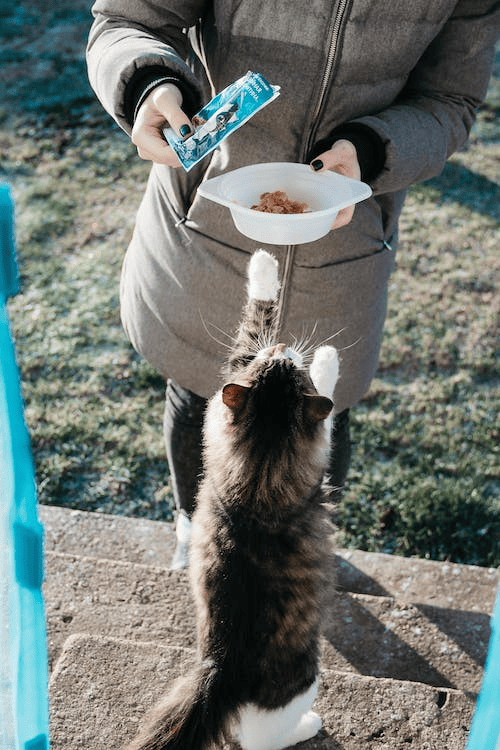Dominant cat behavior relates to understanding the feline hierarchy. Learn more about it here.
Cats are fascinating creatures with intricate social structures. Understanding dominant cat behavior and the feline hierarchy can provide insights into their interactions and relationships with other cats in your home and the outside world. It is a common misconception that domestic cats are solitary animals; in reality, they have a complex social order.
By unraveling this hierarchy, you can better understand your cat’s behaviors and provide a harmonious environment for their social needs. We will delve into the key aspects of dominant cat behavior, including how they establish dominance, communicate within their group, and establish their role within the feline hierarchy.

Credit: meowa.com
The Feline Hierarchy
Uncover the feline dominance hierarchy by delving into the intricacies of cat behavior. Understand the dynamics of dominant cats and their role in establishing a hierarchy within feline social groups.
Welcome to this fascinating journey into the complex world of cats! In this blog post, we will delve deeper into the intriguing phenomenon known as the feline hierarchy. Just like humans, cats have their own social structure, complete with leaders and followers. By understanding the dynamics of dominance in cats, we can gain valuable insights into their behavior and create a harmonious environment in our homes. Let’s begin by exploring the basics of cat social structure.
The Basics Of Cat Social Structure
Cats are known for their independent nature, but they are also inherently social animals. Within a group of cats, whether it be a feral colony or a multicat household, a social hierarchy emerges. This hierarchy, known as the feline hierarchy, determines the relationships and dynamics between individuals.
In a feline hierarchy, there are typically one or more dominant cats who assert their authority over other cats. These dominant cats are often the oldest or strongest members of the group. They have priority access to resources such as food, territory, and mates. Other cats in the group fall into various positions in the hierarchy, ranging from more dominant to more submissive.
Understanding the basics of cat social structure is crucial for cat owners to provide a conducive environment for their pets. By recognizing and respecting the feline hierarchy, we can promote a sense of stability and reduce stress among our feline companions.
Understanding Dominant Cat Behavior
Dominant cat behavior is a fascinating aspect of the feline hierarchy. Dominant cats display certain behaviors and body language to assert their dominance over subordinate cats. These behaviors can include:
- Direct eye contact
- Staring or hissing
- Blocking access to resources
- Keeping a higher position (such as perching on furniture)
- Engaging in aggressive behaviors, such as swatting or biting
It’s important to note that dominant cat behavior is not always aggressive or confrontational. Cats can also establish dominance through more subtle cues, such as scent marking or rubbing against objects. By observing and understanding these behaviors, we can better manage and prevent conflicts among our feline friends.
Signs Of Dominance In Cats
Understanding the signs of dominance in cats is crucial in unraveling their feline hierarchy. Watch for assertive behaviors like body posturing, marking territories, and challenging other cats to establish their dominant status within a household or community. Stay attuned to these subtle cues to better comprehend your cat’s behavior.
Body Language And Posturing
Cats, like humans, have their own unique ways of communicating their dominance. One of the most prominent signs of dominance in cats is their body language and posturing. Paying attention to these subtle cues can help us understand our cat’s social hierarchy better. A cat’s body language speaks volumes about its dominance: – A dominant cat will typically stand tall, with its tail held high in the air. This position allows them to appear larger and more intimidating to others. – They may keep their ears erect and pointed forward, showing alertness and confidence. – Direct eye contact is a sign of dominance in cats. The dominant cat will stare at others without blinking, asserting its authority. – A dominant cat might also arch its back and fluff up its fur, making itself appear even bigger and more threatening. These body language cues are crucial in deciphering the pecking order within a group of cats and understanding the dominant members.Vocalizations And Communication
Apart from body language, vocalizations play a vital role in a cat’s social hierarchy. Cats use various sounds to communicate their dominance and establish their rank within the group. Here are some common vocalizations exhibited by dominant cats: – Growling: A growl is a sign of aggression and dominance in cats. It is a low, intense sound that indicates the cat’s readiness to defend its territory. – Hissing: Hissing is a powerful vocalization used by cats to assert their dominance. It warns others to stay away and serves as a deterrent. – Yowling: Dominant cats may yowl loudly to establish their presence and intimidate others. – Roaring: Rarely heard in domestic cats, roaring is a vocalization used by the biggest and most dominant species of cats, such as lions, to display their dominance and territorial control. By understanding these vocal cues, we can get a glimpse into the intricate social dynamics of our feline friends. In conclusion, recognizing and interpreting the signs of dominance in cats, including their body language and vocalizations, can provide valuable insights into their social hierarchy. By being aware of these cues, cat owners can better understand their pets and create a harmonious environment for all members of the feline family.Common Dominant Behaviors In Cats
Explore the fascinating world of dominant cat behavior and uncover the hierarchy that governs their actions. Gain insights into common dominant behaviors in cats and understand their social dynamics with our informative guide.
Territorial Marking And Spraying
When it comes to marking their territory, cats can be quite possessive. Territorial marking is a common dominant behavior exhibited by cats of all ages and breeds. To assert their dominance, cats will often urinate or spray their scent on various surfaces, such as walls, furniture, or even your personal belongings. This behavior is mainly seen in unneutered male cats, but female cats can also engage in territorial marking.Aggression Towards Other Cats
Cats are independent creatures, and their instinctual need for personal space can lead to aggression towards other cats. This aggressive behavior is often displayed through hissing, growling, or physical attacks. When two cats perceive each other as rivals, they may engage in fights or even engage in territorial disputes to establish dominance. It’s essential to monitor their interactions closely to prevent injuries and ensure a harmonious household. Neutering or spaying your cats can help decrease this aggressive behavior.Food And Resource Guarding
Cats are natural hunters and have a strong instinct to guard their resources, including food, water, and favorite resting spots. Food and resource guarding is another dominant behavior commonly observed in cats. They may become possessive over their food bowls and show aggression when other cats or even humans approach their territory. It’s important to provide separate feeding areas and ensure each cat has access to ample resources to reduce potential conflicts. In conclusion, understanding the common dominant behaviors in cats can assist pet owners in managing their cat’s behavior effectively. By providing a stimulating environment, sufficient resources, and proper socialization, owners can promote a harmonious coexistence among their feline companions and create a balanced and peaceful household.Dealing With Dominant Cat Behavior
Dominant cat behavior can sometimes present challenges for pet owners, but with the right approach, it can be effectively managed. Understanding the feline hierarchy within your household is essential to create a harmonious living environment for both you and your cat. By establishing a hierarchy, providing enrichment and stimulation, and seeking professional help when needed, you can address dominant cat behavior effectively.
Establishing A Hierarchy Within The Household
To address dominant cat behavior, it is crucial to establish a clear hierarchy within your household. Cats are inherently territorial creatures, and they often engage in social hierarchies to establish their position within a group.
To establish this hierarchy:
- Give your dominant cat their own space, such as a separate room or high perch where they can feel secure and maintain a sense of control.
- Ensure that each cat has their own resources, including separate food and water bowls, litter boxes, and scratching posts.
- Introduce structured playtime sessions that allow your cats to expend their energy and establish boundaries.
Creating and maintaining a hierarchy helps your dominant cat feel secure and reduces the likelihood of aggressive or dominating behavior.
Providing Enrichment And Stimulation
Boredom and lack of stimulation can contribute to dominant cat behavior. Providing your cat with enriched environments can alleviate boredom and reduce the likelihood of dominance-related issues. Here are some ways to provide stimulation:
- Introduce interactive toys that encourage mental and physical engagement.
- Set up vertical spaces, such as cat trees or shelves, for climbing and exploring.
- Create hiding spots or cozy areas where your cat can retreat to when they need some alone time.
By providing enrichment and stimulation, you can redirect your cat’s energy towards positive activities and reduce their inclination towards dominant behavior.
Seeking Professional Help
If you’ve tried various techniques and are still struggling to address your cat’s dominant behavior, it may be beneficial to seek professional help. A veterinary behaviorist or a qualified cat behaviorist can assess the situation and provide expert guidance tailored to your specific circumstances. They can help identify the underlying causes of dominance and develop a comprehensive behavior modification plan.
A professional can also help you understand subtle signs and body language exhibited by your dominant cat, enabling you to respond appropriately and prevent escalating conflicts.
In conclusion, dealing with dominant cat behavior requires understanding and proactive steps. By establishing a hierarchy, providing enrichment and stimulation, and seeking professional help when needed, you can create a balanced and peaceful living environment for both you and your feline companion.
Preventing Dominance Issues
Dominant behavior in cats can lead to a number of issues, including aggression, territorial disputes, and overall stress within a multi-cat household. However, with proper preventative measures, you can ensure a harmonious environment for your feline companions. Here are some key strategies to help prevent dominance issues:
Early Socialization And Training
Early socialization plays a crucial role in preventing dominance issues in cats. It involves exposing kittens to various people, animals, and environments during their critical developmental stages. By doing so, you can help them develop positive associations and adaptable personalities.
Additionally, training your cat from an early age can also help discourage dominant behavior. Simple commands such as “sit,” “stay,” and “come” can establish you as the leader and teach your cat acceptable behaviors. Consistency and positive reinforcement are key to successful training.
Neutering/spaying
Another essential step in preventing dominance issues is to have your cat neutered or spayed. This procedure not only helps control the cat population but also reduces hormone-driven behaviors such as territorial marking and aggression.
Neutering or spaying your cat at an early age eliminates the risk of them entering sexual maturity with strong dominance inclinations. It can effectively minimize the chances of dominance-related conflicts, making your cat more sociable and less prone to territorial disputes.
Proper Introductions Between Cats
When bringing a new cat into your home, proper introductions are crucial to prevent dominance issues. Cats are naturally territorial, and sudden changes in their environment can trigger aggressive or dominant behavior.
To ensure a smooth transition, consider the following steps:
- Choose a neutral space for the initial meeting, allowing both cats to investigate and become acquainted without feeling threatened.
- Ensure each cat has their own designated areas for eating, sleeping, and using the litter box. This helps prevent resource guarding and potential dominance-related conflicts.
- Gradually increase supervised interactions between the cats, providing positive reinforcement and rewards for calm and friendly behaviors.
By following these steps and giving your cats time to adjust, you can significantly reduce the likelihood of dominance-related issues and create a harmonious multi-cat household.

Credit: blog.catbandit.com

Credit: meowa.com
Frequently Asked Questions For Dominant Cat Behavior: Unraveling The Feline Hierarchy
What Is The Hierarchy Of Dominance In Cats?
In cats, dominance hierarchy determines social order. Dominant cats assert their authority by displaying aggressive behaviors, while submissive cats yield and avoid conflict. The hierarchy is established by physical confrontations and body language cues. Dominance can dictate access to resources and preferred resting spots.
What Are The Characteristics Of A Dominant Cat?
A dominant cat tends to exhibit assertive behavior, claiming territory, and asserting their authority over other cats. They may display behaviors like blocking pathways, taking charge during play, and being territorial. Need help with your dominant cat? Talk to a veterinarian for guidance.
How Does A Cat Show Dominance Over Another Cat?
Cats show dominance over each other through body language such as hissing, growling, and arched backs. They may also mark territory by spraying urine or rubbing their scent on objects.
What Is The Alpha Cat Syndrome?
Alpha cat syndrome refers to dominant behavior exhibited by some cats. These cats display aggressive tendencies, marking their territory and asserting themselves as the “top cat” in the household. Understanding this behavior can help manage conflicts between cats and create a harmonious environment.
Conclusion
Understanding the dominant cat behavior and feline hierarchy is crucial for cat owners. By gaining insight into the social dynamics of cats, we can create a harmonious environment for our furry friends. Taking cues from their behaviors, we can establish a balanced hierarchy, ensuring that each cat feels secure and respected.
Remember, a happy cat means a happy home. So, let’s continue to unravel the mysteries of the feline world and nurture a strong bond with our feline companions.

